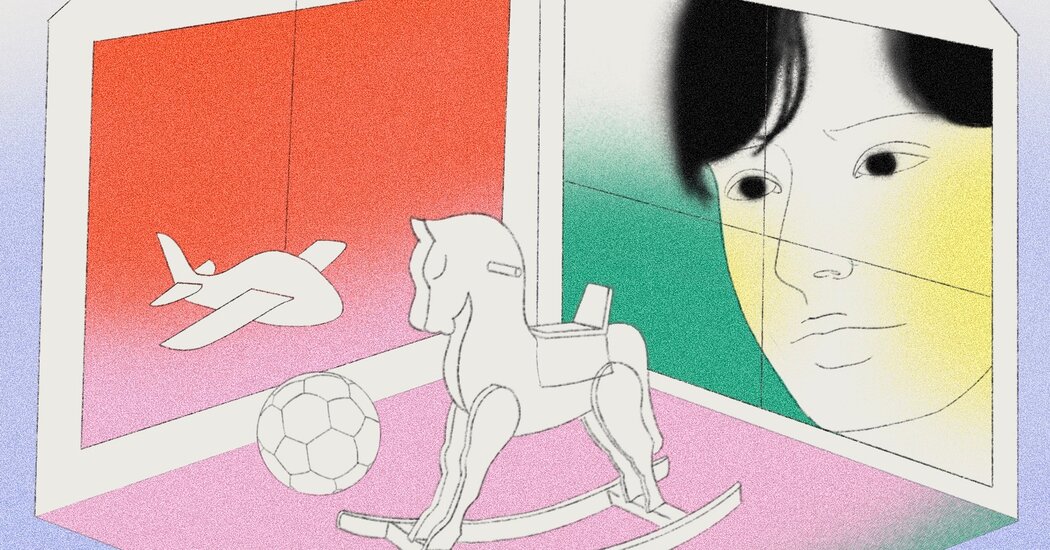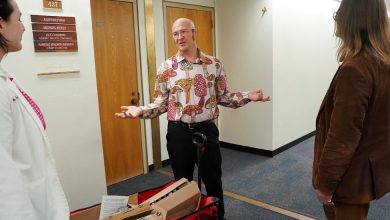You Can Go Home Again, but It’s Complicated

“It’s to stop the dog,” Cindy tells me, as she gestures to the chair that lies across the staircase in the hall. “It’s not to stop you. Would you like to go upstairs?”
It’s been two months since I mailed a letter to Cindy to ask if my husband and I might visit the house where I grew up — a red brick colonial on a leafy street in Pittsfield, the largest city of the Berkshires in western Massachusetts. Twenty minutes ago, Cindy opened the screen door on the north side of the house, the one that faces the narrow drive, and I stepped through it for the first time in a quarter of a century.
That’s more than half my lifetime. When I realize this, I close my eyes and picture not the spinning pages of a calendar but a map.
The largest letters on this map form the name of Pittsfield, my first city. Also marked on it are Kanazawa, Japan, where I spent a summer homestay in high school; Boston, where my parents met in 1968 and where I lived, too, for several years in the late 1990s; João Pessoa, the Brazilian city where my brother was born and where he and I traveled together long after our parents had died, to stand together at the gates of the orphanage where he spent his infancy; and London, where I moved in my late 20s, became comfortable with my sexuality and met my husband. Today, London is where each of my world-spanning journeys as a long-haul pilot begins or ends.
We’ve just finished our walk through the downstairs rooms. When this tour is complete, we’ll have lunch. We’ll have sandwiches, and pie made with blueberries from the garden I once helped to tend. Cindy has prepared the picnic table in the backyard.
But first: Do I want to go upstairs? The small bedroom that was mine is just out of sight, to the left of the uppermost tread.
A childhood home — if we lived in one house or apartment long enough and especially if our family has since moved out — may enclose a nearly undimmed set of early memories, as if its walls formed a time capsule we sealed behind us as we left. And if the possibility of retracing my flight from this Pittsfield house has both troubled and fascinated me for many years — if it’s what recently compelled me to write “Imagine a City,” a memoir and travelogue, and if even now I can’t decide whether to climb this darned staircase — well, my favorite stories remind me that I’m not alone as I grapple with the meaning of return.
I recall a scene from Marilynne Robinson’s novel “Home,” a modern rendition of the parable of the prodigal son, in which Jack — like me, the son of a clergyman — writes a letter: “Dear Father, I will be coming to Gilead in a week or two. I will stay for a while if that is not inconvenient.” After Jack walks into the kitchen for the first time in 20 years, his sister tells him, “The cups are where they always were, and the spoons.” I think, too, of Henry James’s Spencer Brydon in “The Jolly Corner,” who after 33 years abroad returns to his childhood home in New York and an encounter with a ghostly self who never left.
Americans have long been distinguished by the value we place on making — as the maplike expression goes — our own way in the world. (Perhaps it’s only natural in a country formed largely by immigration.) In recent decades our famed national mobility has declined, and the number of young American adults who live with a parent (if not necessarily in their childhood homes) has increased. Nevertheless, Americans can expect to move around 11 times during their lifetime, nearly thrice as often as a typical European, and perhaps to a distant corner of our vast country. In short, the chances that an Americans will spend his or her childhood mostly in one house remain comparatively small.
It’s perhaps unsurprising, then, that Americans spend so much time writing, thinking and singing about our bygone places and our ever-elusive roots. Thomas Wolfe insisted that we can never really go home again. (In fairness, so did the — British — Moody Blues.) Bruce Springsteen not only sings “My Hometown” and “My Father’s House” but also used to drive past one of his childhood homes in Freehold, N.J., several times a week, after dark. (Imagine that: In the smallest hours of your suburban night, you get up, amble sleepily down to the kitchen for a glass of milk, move the curtain to one side and spot the Boss rolling past.)
When online satellite maps were introduced, the first thing I ever searched for was my childhood home. Many friends say the same, and as a pilot, I can report, as well, that the miracle of flight is renewed for me every time I look down — not long after midnight, for example, en route from Mexico City to Heathrow — on the interwoven and faintly neuron-like lights of my sleeping first city.
The reasons we seek to revisit our first homes — in our imaginations, online, from 37,000 feet or by reaching out to the current occupants, whose mailing address, after all, you already have — are as diverse as those doing the seeking. Springsteen, for example, had no quibble with his psychotherapist’s assessment that behind his nocturnal drive-bys lay the subconscious hope of righting something that went wrong in the house long ago.
Vincenzo Di Nicola, an Italian Canadian writer and a child and family psychiatrist at the University of Montreal, has both personal and professional reasons to ponder our longings to return. At 25, he journeyed to the house in Collarmele, in the Abruzzo region, east of Rome, that he left with his mother at the age of 6. As they entered the village, he asked his mother not to guide him, so that he could try (successfully, it turned out) to lead them to their old house. Once inside, he was surprised by the prosaic alterations — larger rooms had been subdivided and running water added — as well as by the potency of memories re-electrified by place and presence. “My father abandoned my mother,” he told me. “To be in the house was to revisit her life and our pain.”
He sometimes recommends that a patient or a friend return to a childhood home, although only after taking a few precautions. The most important of these is to ask a trusted person — someone who might create space for your reactions, without augmenting them — to accompany you, especially if you associate your home with violence or other serious trauma. Generally, he advises, a return to one’s home can be meaningful, and the timing of the inclination itself is usually auspicious. “When it happens to you spontaneously, it almost always represents something,” he said. “Listen to that inner voice. If you feel it, you should do it.”
There is, however, the possibility that nothing will happen, or at least not immediately. “Our culture sets us up for moving along, and then suddenly there’s a luminous moment,” he said. “But not everybody has a Rosebud moment. Things usually don’t tie up nicely, and the best you can do is make your peace with it and move on. Some things remain in pieces.”
Here, back in Pittsfield, I look at the spindles that rise from the left side of the staircase. I used to find it strange that they started square and sharp-edged and became round as they rose and narrowed, until one day I realized that someone I would probably never know had found this arrangement pleasing and had gone to some trouble to draw or specify it; and I’d realized, too, that we find the world but also make it.
I turn my eyes away from the stairs, toward the west-facing front door and the mail slot through which replies from my pen pals in the Philippines, Hong Kong and Australia landed. I remember how I once longed to leave this house behind by climbing — as only a pilot could — to what Joni Mitchell called the “icy altitudes” and crossing over continents and oceans to reach a city like the ones I’d turned to on my globe and a hidden self I believed only distance could set free.
“Well,” I ask Cindy, “if you don’t mind, is it possible to take a quick look in my old room?” She laughs. “I have no idea which room was yours,” she says, “but you can go anywhere you like.”
I thank her and look again to my husband and nod. We step around the barrieronto the first of the treads. I reach for his hand, and together we take them one by one.
Mark Vanhoenacker (@markv747) is a London-based Boeing 787 pilot and the author of “Imagine a City: A Pilot’s Journey Across the Urban World” and “Skyfaring: A Journey With a Pilot.”
The Times is committed to publishing a diversity of letters to the editor. We’d like to hear what you think about this or any of our articles. Here are some tips. And here’s our email: [email protected].
Follow The New York Times Opinion section on Facebook, Twitter (@NYTopinion) and Instagram.




